NORTH WALES COAST RAILWAY:NOTICE
BOARD
Rheilffordd arfordir gogledd Cymru: Hysbysfwrdd
19 November 2012
 Last issue
Last issue Archive
Archive Share this issue:
Tweet
Contributions and comments are encouraged: see the Contributions Page
This site is dedicated to all our regular contributors and supporters, and especially the rail staff of North Wales.
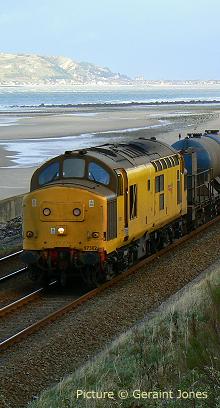
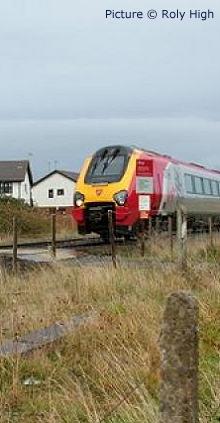
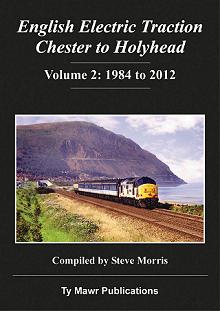
Recent issues
12 November 2012
Saturday 10 November: Rugby Special etc.
Timetable change looms
Grinding in North Wales - pictures by Roly High
Ffestiniog scenes - by Ian Pilkington
Princess leaves Ffestiniog pub - report by Eryl Crump
'Grandad'
Mouldsworth to Helsby memories - by Dave Sallery
Cambrian needs nine million pounds
Come to sunny Rhyl
Derbyshire in a day - with Alan Crawshaw
Brush Corner
The new coaches in close-up - pictures by M.Lloyd Davies
Hawarden from the Air - report by George Jones
05 November 2012
DB Schenker under fire
Changeable weather on Saturday 3 November
Double Grids on timber train - report by Mark Riley
New carriages for Snowdon
Remembrance at Llangollen
Birkenhead Tramway troubles
Picture miscellany
29 October 2012
The Bigger Picture
Premier Service events
Visit the World Cafe
Samaritan commemorated
Locomotive views
Trouble on the Autumn Snowdonian
The 'Spectacular Snowdonian'
In the Vale of Rheidol - with Alistair Grieve
Class 158 tidings
Classic handbills - from Oliver Hambly
On the blocks - with Charlie Hulme
Movie corner
22 October 2012
Diesel memories - pictures by John Young
Saturday Drag, A Traveller's Tale - by Glen Cusack
Discrete electrification?
In the Vale of Rheidol - with Vince Chadwick
Ferry-go-round - report by Mark Riley
The end for Chester Enterprise Centre
Heritage Railway Miscellany
15 October 2012
Gerald's Big Day ... happens!
Cambrian Freight 1982 - looking back with Aled Rees
Leaf-busting season starts
Historic Prestatyn question
Cambrian Coast scenes - pictures by Ian Wright
Ffestiniog Classic
A visit to the East Lancashire Railway - with Alan Crawshaw
Cambrian Award
Llangollen wedding- report by Martin Evans
08 October 2012
Gerald's big day?
Conwy Valley notes - by Larry Davies
Franchise fiasco
Walk the Corwen Extension - with George Jones
Locomotive scenes
A visit to the Penrhyn Quarry Railway - report by Rowan Crawshaw
Llanfairfechan footbridge lift-out
No Steam to Chester 6 October
The Isle of Man - another view - by David Hennessey
Tuesday 24 July
01 October 2012
Weekend events
Another look at the at the Arriva Premier Express
The new 'Irish Mancunian'?
'Last of the Summer WAG', or 'The Long Way Round' - by
Class 97/3 doings - report by Mark Watson
Corwen Project Update - by George Jones
Looking back
Corwen exhibition - report by George Jones
To Dundee, come Hell or High Water - report by Roly High
New book on Ruabon to Barmouth - reviewed by George Jones
24 September 2012
Archive addition: 37s on Ballast
Stormy Weather
Class 56 on the logs
Exhibition: Corwen, A Railway Town
Llangollen's Autumn Diesel Day 22 September
Quarry Power on the Welsh Highland - report by Ian
Club 55 to Cheltenham (and website woes) - by Stephen Hughes
20 September 2012
All Change for the Premier Service - special issue
Forthcoming events
This list may be out of date if you are reading an archived page. For the current list visit our Calendar.
November 2012
Wednesday 28 November Ffestiniog Railway Society My life with trains. B.Bushell.
Thursday 29 November Merseyside Railway History Group Andrew Scott: Around the world with 80 trains.
December 2012
Friday 7 December Clwyd Railway Circle Members Night & Christmas Celebration. Members are invited to give a 15/20 minute presentation of their choice (any format). This will be interrupted by festive treats (all high calories). Members must book their slot with David Jones no later than 20 November.
Saturday 8 December Railway and Canal Historical Society "Widely as his Mersey Flows" by Hugh Beggs
Monday 10 December Wrexham Railway Society Society's Annual General meeting followed by members' Rail Review.
Thursday 13 December Llandudno and Conwy Valley Railway Society Christmas Social helped along by members Alex Cowan confirming to us that “Trainspotting was an education” and Larry Davies taking us back to “1962 – a year of change”
Thursday 13 December Merseyside Railway History Group Angus Tilston: Film & Social evening
Thursday 13 December LCGB North West Les Nixon "55 Years of Railway Photography – Part Two"
Friday 14 December Altrincham Electric Railway Society "Steam Saved from the Scrapyard" a colour slide presentation by Tom Heavyside.
Saturday 15 December Rhyl & District Model Railway Club Charity Model Railway Exhibition, Parish Hall & Scout HQ, Top of Central Car Park, Prestatyn, 10:30 to 16:00.
Monday 17 December RCTS Chester Members Slide/Digital Images – 30 Slides or artefacts of your Choice
January 2013
Friday 4 January Clwyd Railway Circle Pete Gray “Welsh Highland Railway” Our speaker for the night is the Safety & Development Manager of the WHR; previous to this, he was the Construction Manager from 2006-2010. Pete will be talking about his experiences during this time and the organization that is needed to keep the show on the road.
Thursday 10 January Llandudno and Conwy Valley Railway Society “Early Railways of Gwynedd 1790- 1830’s” Dr Dafydd Gwynn
Friday 11 January Altrincham Electric Railway Society "Transport around Manchester from 1750" a colour slide presentation by Chris Makepeace.
Saturday 12 January Railway and Canal Historical Society Group Annual General Meeting commencing at 13:45 followed at 14:30 by "Members Choice".
Thursday 17 January LCGB North West Keith Naylor "Isle of Wight Railways"
Monday 21 January RCTS Chester Branch A.G.M. followed By British slides between 1983 & 2010 By Alan Donaldson.
Thursday 31 January Merseyside Railway History Group Geoff Coward: Northeast China Steam 2002
February 2013
Friday 1 February Clwyd Railway Circle Gordon Davies “American Wanderings 2, the Great Plains Drifter” - Recollections of Gordon’s trip in 2008, covering the largest open cast mine in Wyoming plus the world’s largest marshalling yard.
Friday 8 February Altrincham Electric Railway Society "The Lynton & Barnstaple Railway" a digital presentation by Bob Barnard.
Saturday 9 February Railway and Canal Historical Society "The Manchester Bolton and Bury Canal, its history and restoration" by Dr. Paul Hindle.
Thursday 14 February Llandudno and Conwy Valley Railway Society “My Life in Crewe Works” Arthur Jones
Monday 18 February RCTS Chester The Northern Hub. A Talk By Duncan Law, Senior Programme Development Manager, Network Rail.
Thursday 21 February LCGB North West Mike Taylor "Preston and North"
Thursday 28 February Merseyside Railway History Group Dave Southern: Rails to Blaenau Festiniog
March 2013
Friday 1 March Clwyd Railway Circle The Committee & Larry Davies. AGM followed by the talk “60 years ago – Diamond days” After the formality is over, we look forward to the talk by one of our favourite speakers.
Friday 8 March Altrincham Electric Railway Society "The ICI Hopper Trains" a colour slide presentation by Brian Arnold.
Saturday 9 March Railway and Canal Historical Society "Lost Canals of the East Midlands" by the Society's President, Dr. Wendy Freer
Thursday 14 March Llandudno and Conwy Valley Railway Society “Polish Steam” Brian Bollington & Pete Hanahoe
Monday 18 March RCTS Chester B.R in the early 1980’s By Tom Heavyside.
Thursday 21 March LCGB North West Tony Harrison "The Dragon's Last Roar"
Thursday 28 March Merseyside Railway History Group AGM: Members Slides
April 2013
Friday 5 April Clwyd Railway Circle Michael Murphy 'Liverpool Overhead Railway' To finish off the season, a highly recommended speaker known for his light-hearted style of presentation. The talk will be followed by film footage of the railway in its heyday.
Thursday 11 April Llandudno and Conwy Valley Railway Society “Chester to Holyhead English Electric traction 1984 – Present day” Steve Morris
Friday 12 April Altrincham Electric Railway Society "Current Developments on Metrolink" a digital presentation by Tony Williams, Manchester Area Officer, Light Rail Transit Association.
Saturday 13 April Railway and Canal Historical Society "The General Strike & the Railways" by Dr. Robin Smith
Monday 15 April RCTS Chester Even Further Down Under: New Zealand In 2011 & 2012 By Geoff Morris.
Thursday 18 April LCGB North West John Sloane 'Steam Sheds and Diesel Depots'
Thursday 25 April Merseyside Railway History Group Richard Kells : Quiz and informal evening
May 2013
Thursday 9 May Llandudno and Conwy Valley Railway Society “The Buckley Railway” Paul Davies
Thursday 16 May LCGB North West AGM and Members/Visitors Slides & Digital Photos.
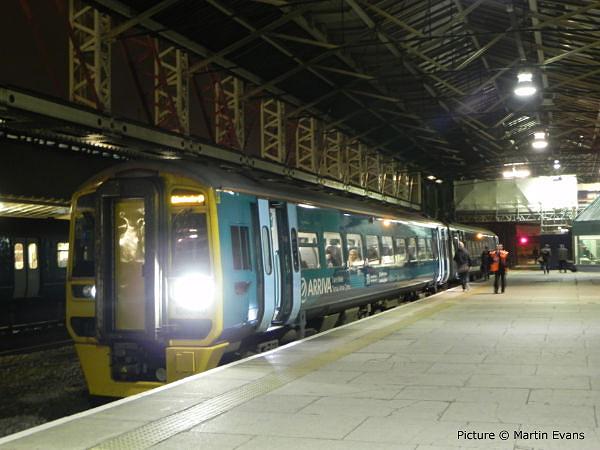
158 840 waits to depart Chester for Manchester Piccadilly at 18:16, 15 November: Class 158s have some Manchester workings among the Class 175s since the timetable change in September. Picture by Martin Evans.
Bangor Shed mystery
We've had an email from Anthony Ashley, who writes:
I live in Australia and am
creating a large N scale layout based on the North Welsh coast in the
period 1960-65. I have built a large shed to house the layout it, which
will be 35'X16'. I have been researching for approximately nine months
and have pictures of most of the rail facilities for the three stations
including Conwy, Penmaenmawr and Bangor.
There were three large sheds adjacent to Bangor station. In N scale each shed will be approx 2' X 1'. The three sheds were the engine, goods and wagon or engine repair shed. The engine and goods sheds still exist and I have photos of them which provide the basis for an accurate model. Unfortunately the repair shed, which I believe had office accommodation above it has been demolished and I have been unable to find any pictures of the structure. In addition, the material available for Conwy station in the first half of the 1960s is also limited.
I have tried the HMRS, York Rail Museum, the LMS and LNWR societies for information but without much success. Do you have any ideas or access to material showing the Bangor repair shed and/or Conwy station which you would be willing to provide me. The 3 sheds going from east to west in the station were the engine, goods and then the repair shed. I believe the repair shed was demolished after 1966.
There were three large sheds adjacent to Bangor station. In N scale each shed will be approx 2' X 1'. The three sheds were the engine, goods and wagon or engine repair shed. The engine and goods sheds still exist and I have photos of them which provide the basis for an accurate model. Unfortunately the repair shed, which I believe had office accommodation above it has been demolished and I have been unable to find any pictures of the structure. In addition, the material available for Conwy station in the first half of the 1960s is also limited.
I have tried the HMRS, York Rail Museum, the LMS and LNWR societies for information but without much success. Do you have any ideas or access to material showing the Bangor repair shed and/or Conwy station which you would be willing to provide me. The 3 sheds going from east to west in the station were the engine, goods and then the repair shed. I believe the repair shed was demolished after 1966.
Easy, you might think; Bangor's railway installations are very well documented, thanks to various authors, especially the late Bill Rear who worked as a fireman from the loco shed, and also had access to the material collected by former shedmaster J.M.Dunn. An entire book on Bangor in the Foxline 'Scenes from the Past' series, well illustrated and full of pictures, has recently been re-issued by Book Law publishers, and immensely interesting it is too.
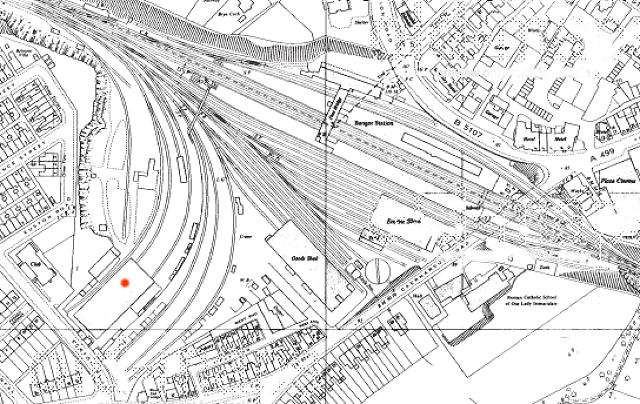
However, the Repair Shed mentioned by Anthony, and seen on the above map, is only mentioned in passing.
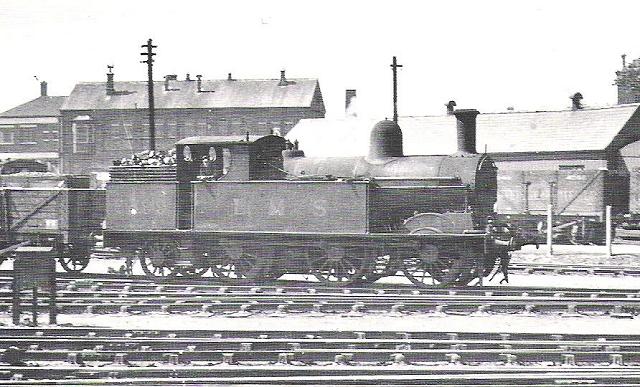
This old picture, from one of Bill Rear's other books appears to show a shed with offices above, but it doesn't seem to be big enough, or match with the tracks and pointwork seen in the foreground. We'd be pleased if anyone could throw any light on this strangely elusive structure, or even provide a picture suitable for a modeller to work from. The building's road frontage was adjacent to the Railway Institute, current meeting place of the North Wales Railway Circle. We've looked in all the obvious sources, but the site is frustratingly just off the edge of the many panoramic views taken from above the tunnels.
If you can help, do let us know and we'll pass the details, and your email address if you wish, on to Anthony and also feature it here. His project seems well worth and, as he says, time spent on research is never wasted. He'd also be interested in details of the formations of the 'Irish Mail' in the early 1960s.
Network Rail assortment
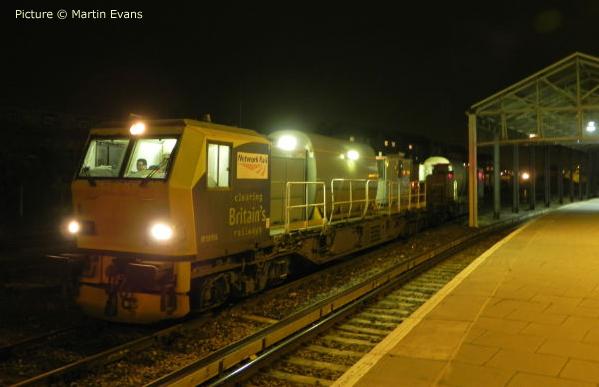
Network Rail Multi-Purpose Vehicle twin-unit DR98954 and DR98904, in Rail Head Treatment Train configuration, waits to depart Chester for Hooton and the Wirral at 18:20 on 15 November (Martin Evans).
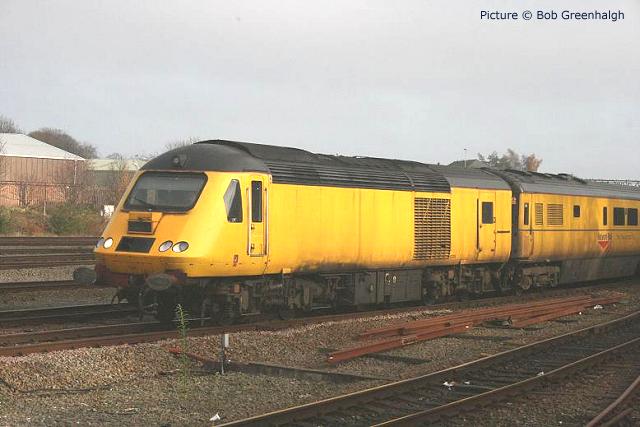
Looking rather care worn, 43 014 leads the Network Rail 'New Measurement Train', which records the state of the track, through Chester heading for North Wales, on 15 November. (Stavros Lainas).
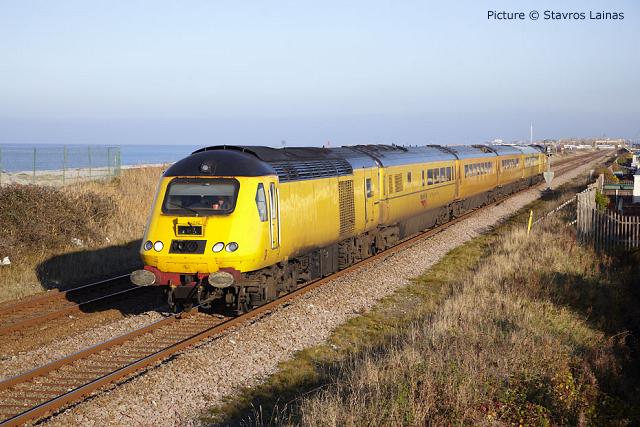
Approaching Abergele at 14:05 (Stavros Lainas). The box under the windscreen houses the video cameras; it has its own windscreen-wiper.
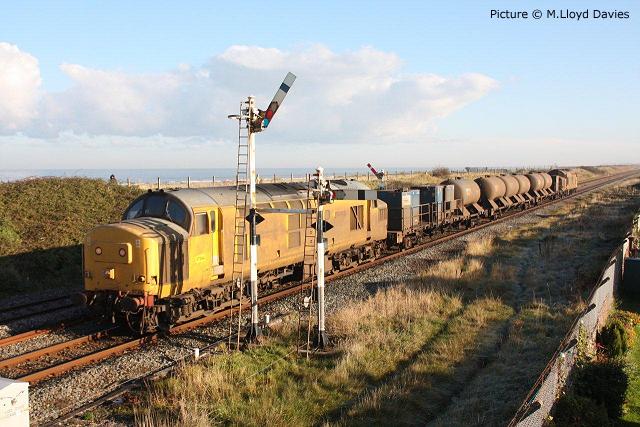
The North Wales and Cambrian Rail Head Treatment Train continues its weekday cycle until 8 December (or earlier if conditions permit.) Here are two views by M.Lloyd Davies taken in autumnal sunshine: above, 97 304 passing Abergele on 5 November ...
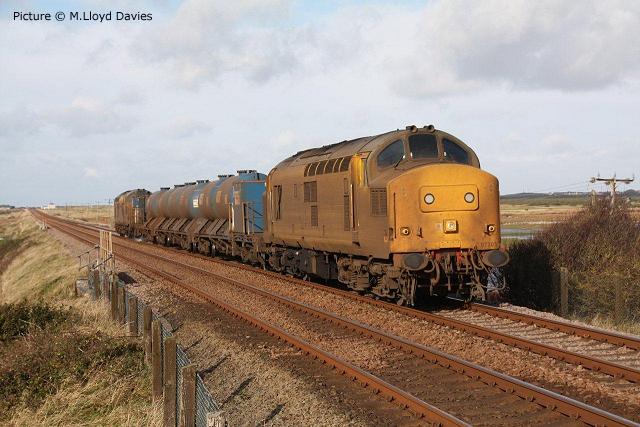
and 97 303 near Rhosneigr on 12 November.
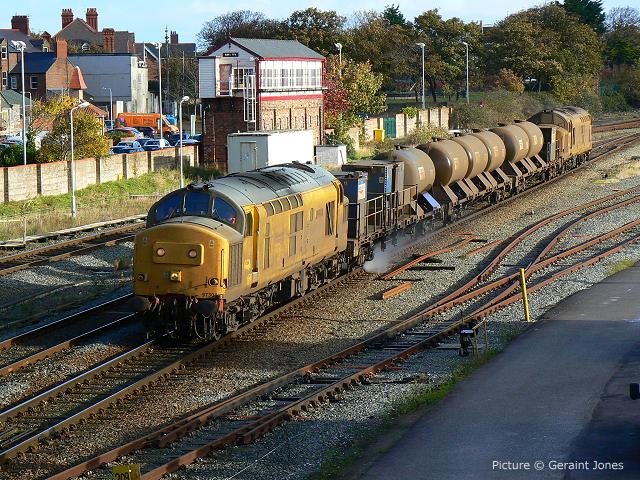
97 304 at Rhyl, 2 November (Geraint Jones)
Christmas at Bala
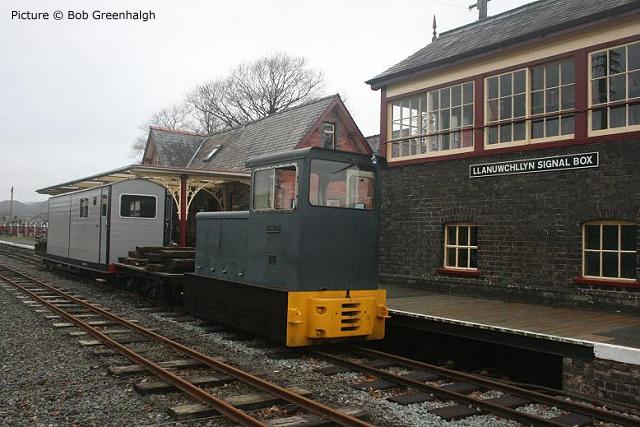
On Wednesday 14 November, Bala Lake Railway diesel loco Bob Davies and the works wagon stand in Llanuwchllyn station ready for the 'Wednesday Gang' to start on the day's tasks. Picture by Bob Greenhalgh.
That old chap with the red dressing gown, white beard and sack will be visiting the railway on Saturday and Sunday 8 and 9 December, with Santa Special trains and presents for the children. (On the Sunday the guard of the train will be our own Mr Greenhalgh.)
See the decorated stations, lights and Christmas trees. With decorated steam locos each end, the push-me-pull-you train will take you on a gentle trip to the Lake of Serenity to meet Santa in his grotto. Visit the Bala Lake Railway website for details; advance booking essential on 01678 540666.
Hop on our 'Merry-Maker' - with Stephen Hughes
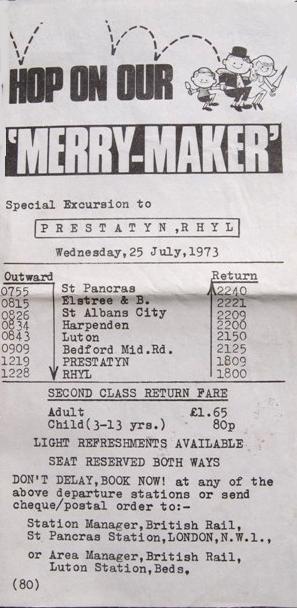 The
news report in last week's update headed 'Come to Sunny Rhyl' reminded
me of a flyer that I came across a couple of months ago, for a
Merrymaker excursion from St Pancras and stations to Bedford to
Prestatyn and Rhyl (My father was working from Bedford Midland Road at
the time and used the flyer as a piece of scrap paper for some notes).
The
news report in last week's update headed 'Come to Sunny Rhyl' reminded
me of a flyer that I came across a couple of months ago, for a
Merrymaker excursion from St Pancras and stations to Bedford to
Prestatyn and Rhyl (My father was working from Bedford Midland Road at
the time and used the flyer as a piece of scrap paper for some notes).I'm sure many readers will remember Merrymakers. I think that the idea for such excursions, utilising spare locos and stock usually at weekends, originated in the Midland Region and subsequently caught on across almost the whole of the network. They must have been great for enthusiasts at the time, with the opportunity to travel directly to an interesting - often seaside - destination directly from your local station. To the best of my knowledge I only travelled on a Merrymaker on one occasion - from Todmorden to Stratford-upon-Avon.
This particular Merrymaker to the North Wales coast is not listed in 'Six Bells Junction' but of course that does not mean that it didn't run; I wonder if anyone can recall it or has a photograph? Presumably it would have brought a Class 45 to North Wales, as they were the usual motive power on the Midland Main Line at the time and, I would imagine, unusual in North Wales at the time.
About Mark 3 coach bogies
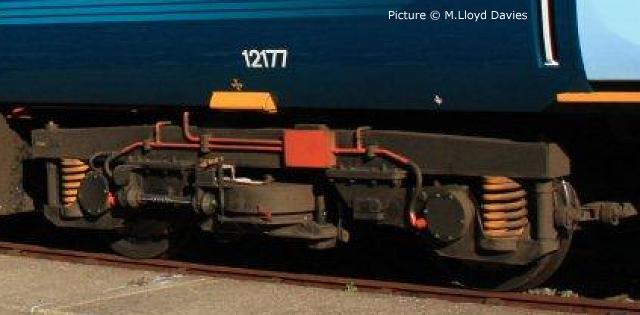
One of the satisfying things about running this website is that it is read by people within the rail industry, who will respond with enthusiasm to technical questions. A case in point related to the picture above (by M.Lloyd Davies) which we included in the last issue with a question about the purpose of the orange box and cables. The following is complied from the several such replies received.
The bogies under these coaches are of the BT10 type designed by British Rail Engineering for the Mark 3 coaches in High Speed Train sets; for the latter, 125 mph capability was required. A loco-hauled version, Mark 3a, was also produced and had the same bogies. The conduit and junction box on the bogie is associated with the automatic Wheel Slide Protection (WSP) system. The WSP system monitors the rotation of the axles and reduces the brake cylinder pressure on a particular axle if that axle starts to lock up which can lead to sliding which damages the wheels as well as causing problems stopping the train. This problem is particularly common under low-adhesion conditions such as during autumnal leaf fall.
As soon as normal rotation of the axle resumes, the brake cylinder pressure returns to that demanded by the driver. All of this happens in a split second and you can sometimes hear it happening (short pneumatic bursts) when sitting inside the vehicle. The system allows the driver to keep control of the train under low adhesion conditions and in theory prevents 'wheel flats' although this depends on the effectiveness of the WSP system in question - some are better than others - for instance, anybody who rides in class 323 electric trains in the autumn will appreciate this from the familiar 'bang' from under the coach for every revolution of the axle.
The flat circular enclosures on the axle ends contain toothed wheels bolted to the axles themselves and the cable entering the enclosure is for the sensor that detects the rotational speed of the wheels - by effectively counting the rate that the teeth are passing. The two electrical feeds that disappear across the top of the bogie frame go to the 'dump valves' that momentarily release the brakes, while the other electrical connection towards the vehicle body goes to the electronic control rack, which is the 'brain' of the system.
The six coaches recently
refurbished for Arriva Trains Wales, now numbered 12176 to 12181, were
originally Mark 3b First Class 'Pullman' carriages 11064 / 065 / 071 /
083 / 084 / 086 from a batch built in 1985, and as such were the
ultimate development of the Mark 3 loco hauled vehicle as originally
created. They were not actually Pullmans in the strict sense, but were
marketed as luxury travel for business people. No supplement was
charged over normal First Class, and they were included in most trains
on their routes. 22 vehicles, 11073-94, were to replace the Mk2
Pullmans used on the 'Manchester Pullman' service and perpetuated the
theme, first used on the Mk2 Pullmans in their later days, of naming
after local heroes. 11083 was Kitty
Wilkinson, 11084 William
Roscoe, and 11086 Henry
Doulton.
These Mark 3b vehicles have the most advanced WSP system, with one central WSP rack monitoring all four axles. It does this by comparing the frequency signals from the sensors on each axle - in an ideal world all the frequencies should be the same. The system can be programmed with the actual sizes of the wheels; a brand new full size wheelset will rotate more slowly than a fully-worn one. When the control rack detects that one or more axles is slowing down relative to other axles on the vehicle (because they are about to lock-up), it operates the dump valves.
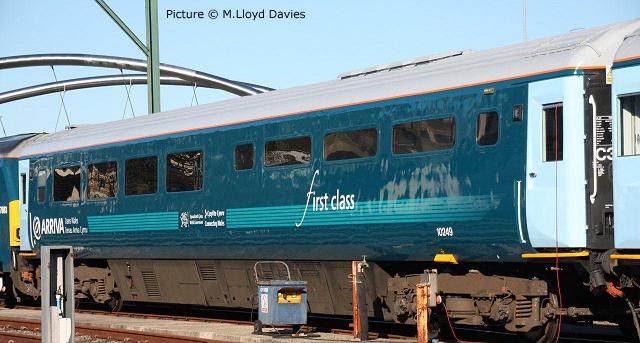
Looking at Kitchen Buffet First 10249, this does not have the electrical cabling on the side of the bogie. This coach was converted from Mark 3a Restaurant Buffet car 10012, built in 1979, and has an earlier version of WSP fitted. On the axle-ends of the nearest bogie are small electrical generators and these feed a simple electronic unit that compares the voltage output from each axle - if the axle is about to lock-up the output falls and the dump valve is operated to release the brakes. This system is cruder than the Mark 3b version.
In British Rail days the Mark 3b Pullmans were always seen by maintenance staff as the 'cream of the fleet', as apart from the better WSP system and nicer interiors, they had more reliable Motor Alternators (part of the electrical supply for the vehicle) and the automatic vestibule doors were hardly any trouble when compared to the 1970s Mark 3 vehicles.
Many thanks to those who took the time to answer our question.
Ayrshire Yeomanry at Llangollen - report by George Jones
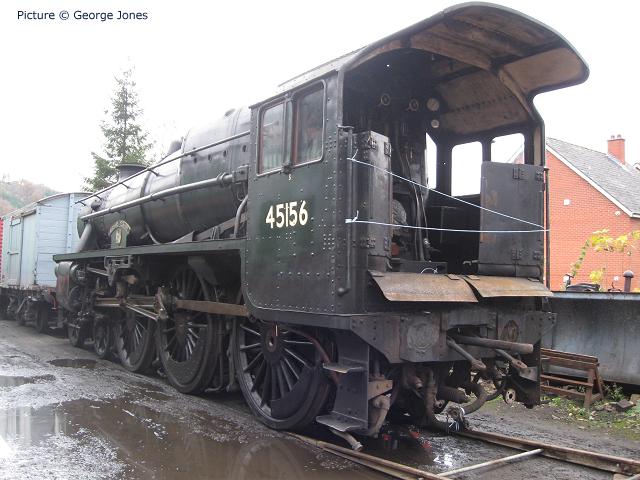
Delivered to the Llangollen Railway on 14 November was the erstwhile 45156 Ayrshire Yeomanry of blessed memory, once of 8A Edge Hill Motive Power Depot, as I recall, it its latter days, later Patricroft and finally Rose Grove.
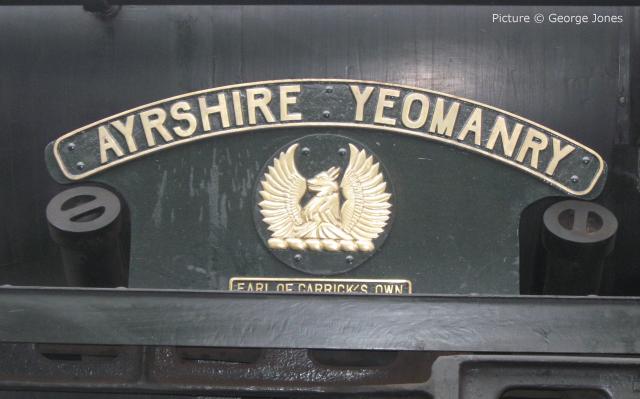
It is in fact a renumbering of sister 'Black 5' 4-6-0 45337, paying a maintenance visit from the North Norfolk Railway, but wearing a false identity complete with nameplates. The nameplate seems to have acquired an additional subtitle and a badge as a refinement.
Club 55 to Barry - report by Richard Fleckney
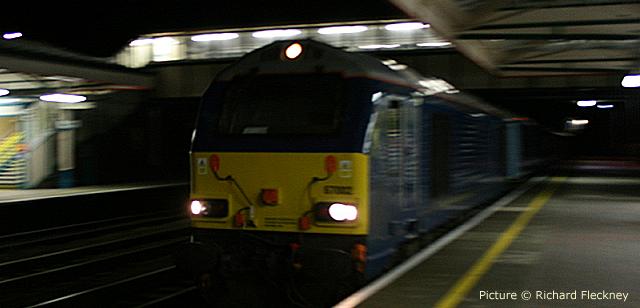
On 15 November a small group of North Wales Railway Circle members took the early Premier Express to Cardiff Central Club-55-wise, with 67 002 leading, seen above arriving at Bangor on time at 06:00. Everything was OK till Chester, where the train reverses and the driver relocates to the Driving Van Trailer. We then waited; apparently the DVT electrics didn't match up, but after 27 minutes and apologies from the staff we moved away for an excellent run to Cardiff, though the weather was rather foggy.
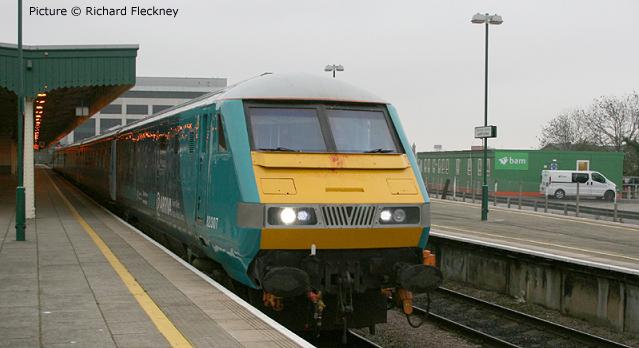
We rolled into Cardiff - above, with 82307 at the front - only about 10 minutes late.
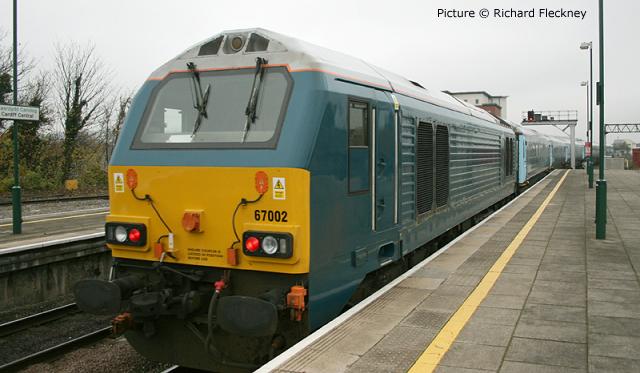
The empty train leaves Cardiff Central for servicing at Canton depot, with 67 002 propelling.
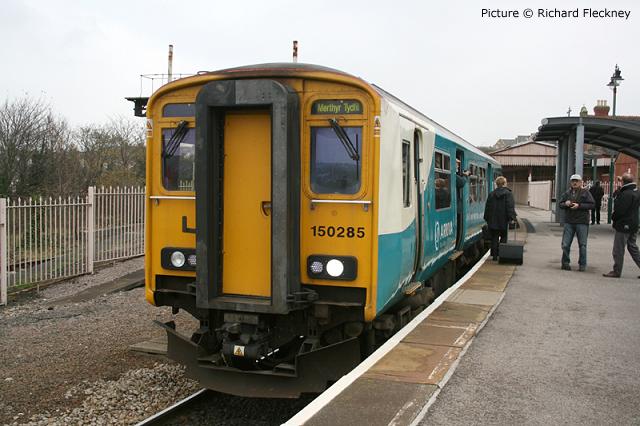
After a few freight trains had passed we took 150 285 to Barry Island (above); the conductress was very helpful in advising us of some routes to take in future. Behind the fence can be glimpsed the track of the Barry Tourist Railway, which uses what was once the second track of the double-track between Barry island and Barry. The Tourist Railway was not running on this day, but like many heritage railways will be operating Santa Specials at weekends during December: see the Barry Tourist Railway website. The line has some interesting 'classic' traction: a Class 101 railcar, and a Class 73 Electro-diesel loco which works with ex-Gatwick Express coaches.
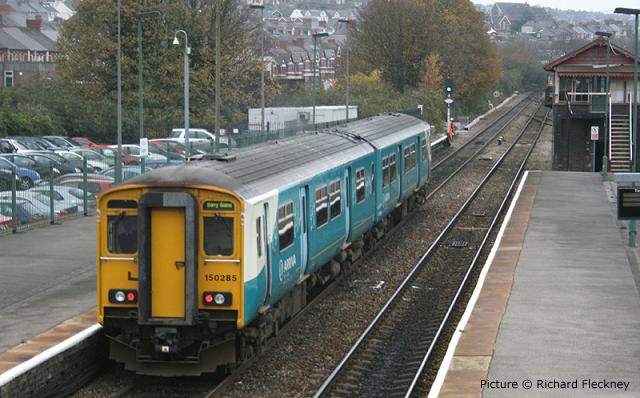
Back up the line for the short run to to Barry, 150 285 departs towards Cardiff past the signalbox built by Evans, O'Donnell & Co in 1897 for the Barry Railway company, one of the South Wales independents which were merged into the Great Western in 1923. See also the marvellous Signal Box website.
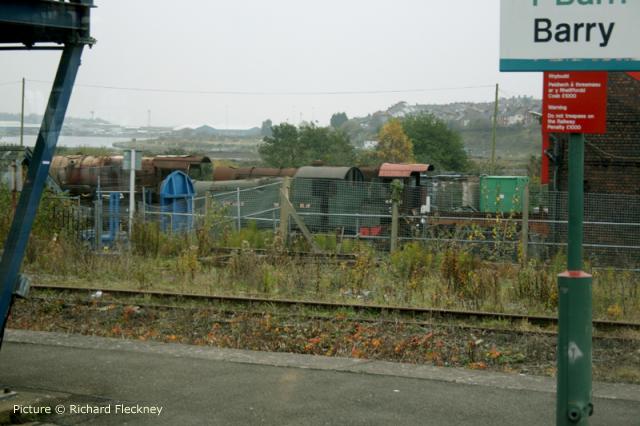
In the former EWS depot opposite Barry station, not open to the public, a few old relics are rusting away, the remains of the last locomotives removed from the legendary Woodham's scrapyard from which many locomotives were rescued and put back into service. Apparently, there are plans to restore most of these.
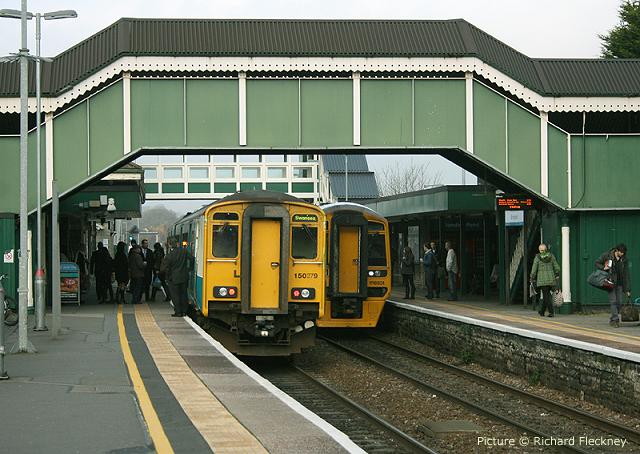
On, aboard 150 279, to Bridgend, with its characteristic Great Western footbridge ...
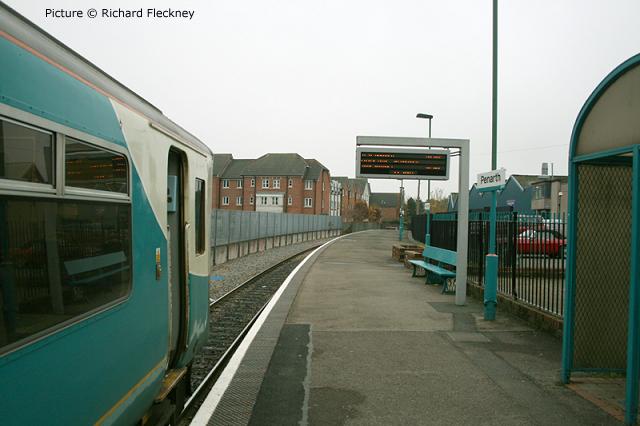
... then Penarth ...
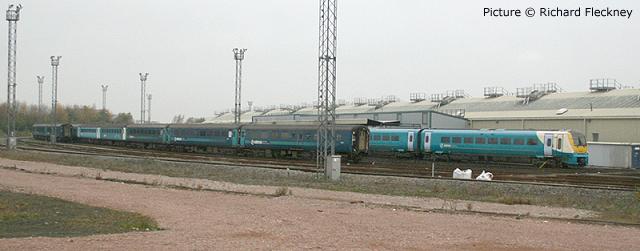
... and finally back to Cardiff, passing Cardiff Canton, Arriva Trains Wales' main depot, where the displaced Mk2 coaches from the Premier Express, as well as some of the Mk2 coaches still wearing the original Arriva livery, await their fate.
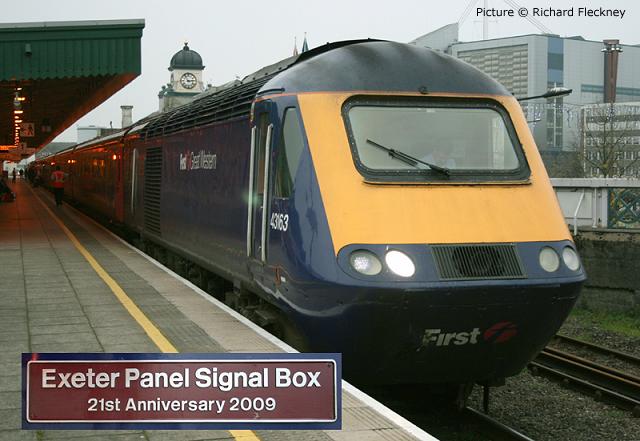
First Great Western HST bound for London at Cardiff Central, led by 43 163, romantically named Exeter Panel Signal Box 21st Anniversary 2009, which was the rear locomotive of the train which ran disastrously into a freight train at Southall, London in 1997.
The Prince of Wales (once a theatre, now a Wetherspoon) was voted on for a meal and a pint, then the Ian Allan bookshop in Royal Arcade for more reading matter, then the 15:21 Class 175 back home. Many thanks to Arriva staff for a good day out.
[Additional notes by Charlie Hulme.]
Christmas Reading
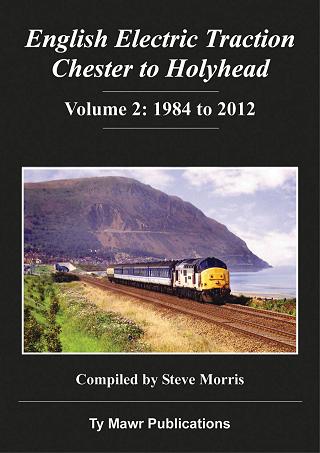 Available just in time
for the festive season is Steve Morris's
latest publication English Electric
Traction Chester to Holyhead, Volume 2: 1984 to 2012.
Hardback with 96 pages in A4 format, this volume spans the period 1984
to 2012 and follows on from volume one published in 2011. It contains
over 200 images, almost all in colour, covering classes 20, 37, 40, 50,
55 and 73.
Available just in time
for the festive season is Steve Morris's
latest publication English Electric
Traction Chester to Holyhead, Volume 2: 1984 to 2012.
Hardback with 96 pages in A4 format, this volume spans the period 1984
to 2012 and follows on from volume one published in 2011. It contains
over 200 images, almost all in colour, covering classes 20, 37, 40, 50,
55 and 73. Priced at £17.95 and limited to only 750 copies, this compilation completes the full story of English Electric Traction in North Wales and will be a valuable addition to the collection of any railway enthusiast who reads our website, to which Steve himself is a regular contributor. reader of this site. Highlights include rare workings including 'firsts' and 'lasts' as well as unique images recorded by railwaymen during the course of their work, with interesting views of oncoming trains taken from the cab.
The period covered includes the classic years from 1993 to 2000 when Class 37/4s hauled several trains each day along the coast line, and the book features a good selection of views of these, including the fine cover picture. Copies are available from eBay or via the Ty Mawr Publications website.
For enthusiasts of a steam-oriented persuasion, the December 2012 issue, now in the bookstalls, of Steam Days magazine will be of interest, as it includes a long article 'Steam Days at Llandudno Junction' on the history, trains and people of the railways in the Llandudno Junction area with some interesting stories and photographs of a variety of steam locos. The author does bring the story up to date, but seems to be a little less sure of himself with non-steam traction, describing a Class 104 unit as a 'Derby Lightweight.'
Sandy Lane crossing - pictures by Roly High

Since 1 April 2012 two pedestrians and one cyclist have lost their lives at footpath crossings on the Network Rail system. More people are killed at footpath crossings than any other type of crossing; since 2007 there have been 24 fatalities at footpath crossings. Network Rail (that's their puiblicity picture above) have been running an advertising campaign and have plans to spend money dealing with this problem.
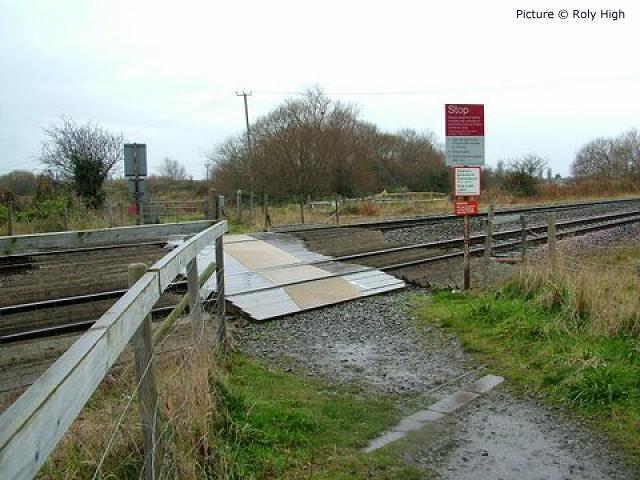
This news prompted Roly High to make a picture survey of one such crossing at Sandy Lane, Prestatyn, which is to be the subject of a public meeting at the Prestatyn Nova Centre on Thursday 22 November at 19:00.
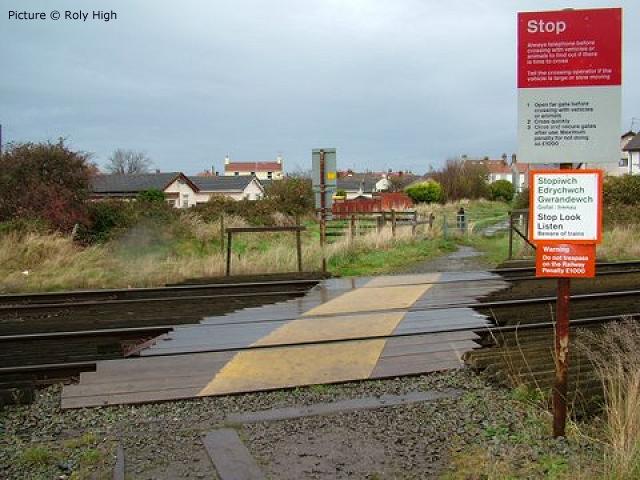
Above: A view from the crossing gate. The crossing is of the type coded 'UWG' - User-Worked Gates. Pedestrians and cyclists can cross freely, but quickly and carefully! The sign explains that drivers of vehicles or animals must run the signaller using the phone provided.
Network Rail say 'We're considering a number of options to reduce risk and increase the safety of pedestrians and train passengers, But the main purpose of this meeting is to explain the safety problems to the community. The Sandy Lane footpath crossing in North Wales is one which we have identified as carrying some risk to the public because of the level of usage and the frequency and line speed of scheduled services at that point.'
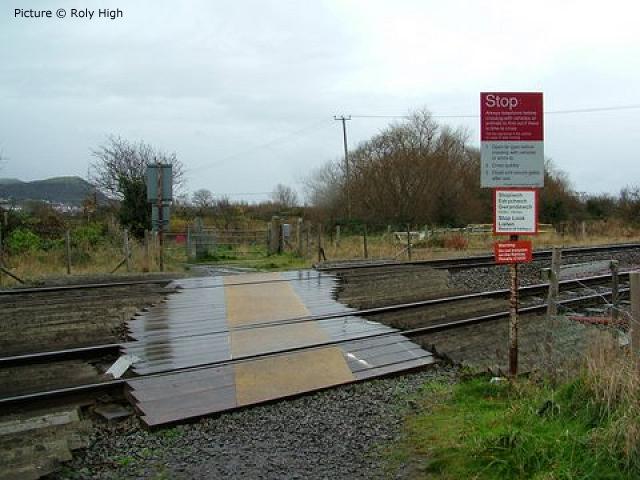
The crossing is well signed, with bilingual safety notices. This path is officially a Public Footpath with access for landowner's vehicles.
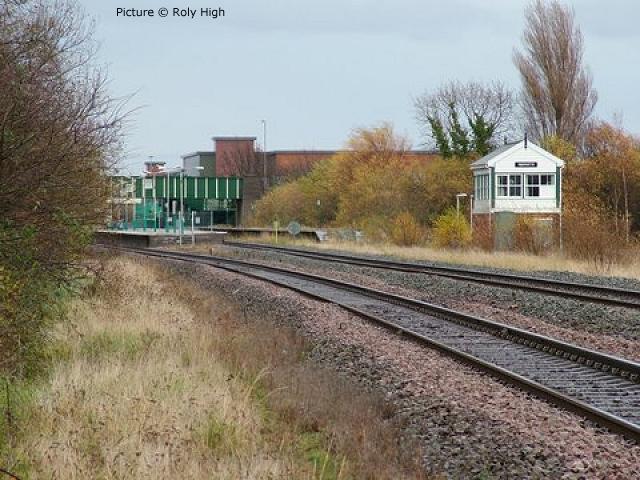
The line speed of trains not stopping at Prestatyn on this section of track is quite high: 75 mph through the station and 90 on both lines in the Rhyl direction. [A correspondent informs us that there has, for about a year or more, been a temporary speed restriction of 75mph before the crossing due to sighting distance on both the Up and Down lines.]
The picture above looks east towards Prestatyn signal box; that undergrowth perhaps needs cutting back. The crossing leads to a playing field, is at the point where the track former branch line to Dyserth curves away behind the signalbox. The trackbed is now a footpath and cycleway, although the first section around the curve has not been retained: users have to use the road bridge to reach it.
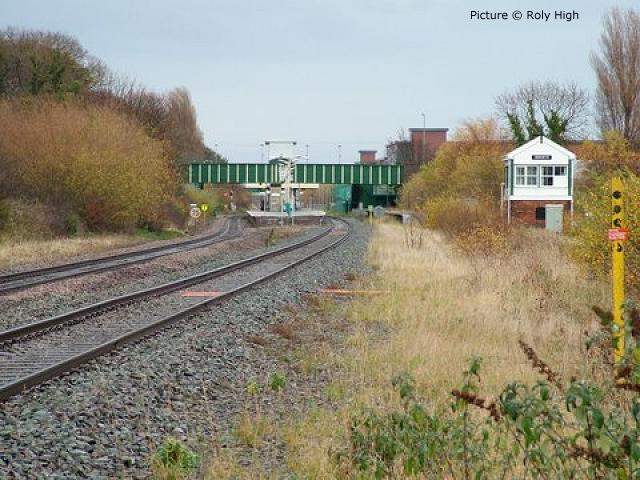
The view from the other side of the track. The crossing is located 205 miles 62 chains from London. The signalbox is at 205 m 52ch and the station at 205m 42 ch, so a train heading west will be clearly visible passing the station approximately 20 chains - 440 yards - from the crossing. The signs marking speed restriction can be seen: actual speed at the crossing is unlikely to be more than 75. The yellow post is milepost 205¾.
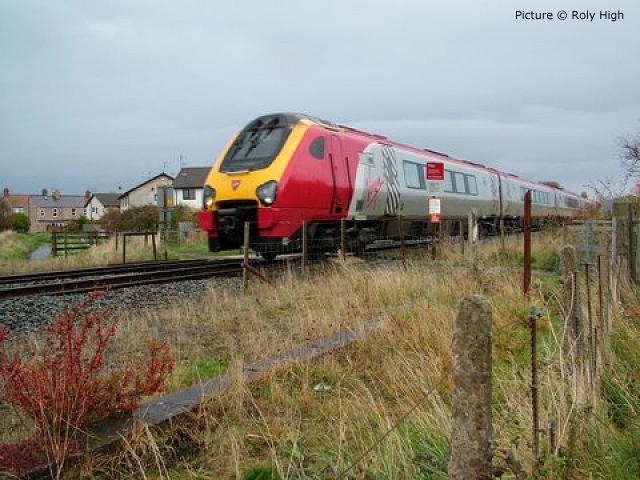
The 09:10 London Euston to Holyhead, not booked to call at Prestatyn, blasts over the crossing in the form of Virgin Super Voyager 221 142 Bombardier Voyager.
Here is Network Rail's information about User-Worked Crossings.
Bridges at Berwyn - report by George Jones
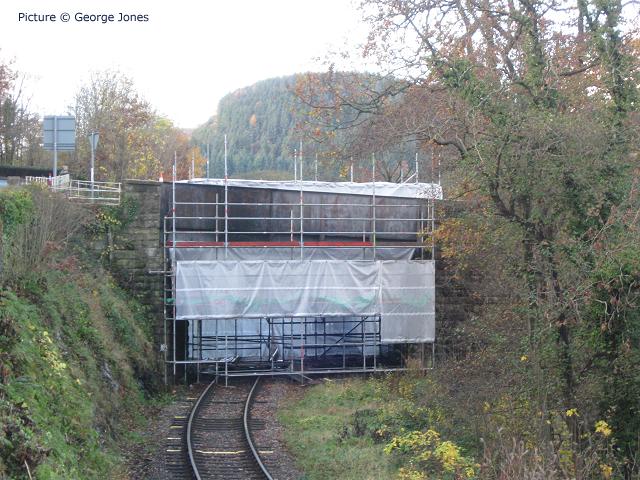
A Saturday 17 November visit to Berwyn on the Llangollen Railway allowed for examination of the overbridge carrying the side road from the A5 west of the station which is now under repair. The picture above shows the bridge encased in tarpaulins whilst sandblasting takes place as part of the work by Denbighshire County Council.
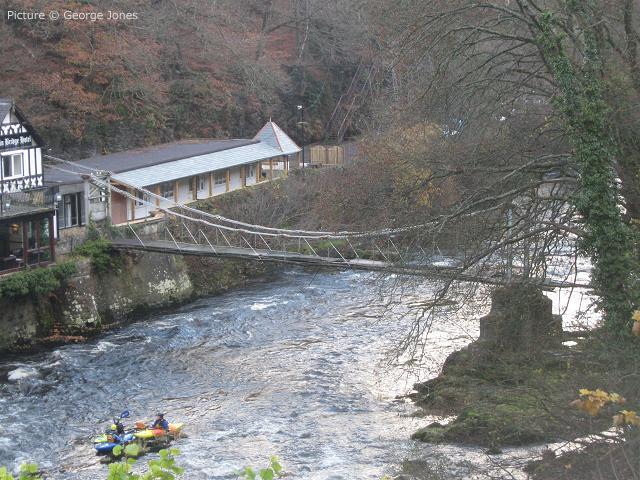
The chain bridge over the River Dee nearby, as mentioned in an earlier report, meanwhile awaits salvation; as shown in these pictures it is in a very bad state. The bridge was originally created to give direct access to the Chainbridge Hotel, which is still in business, but the bridge has been closed as unsafe for many years and visitors must use the road bridge.
The local development project to acquire Heritage Lottery Fund (HLF) assistance with the restoration proceeds, but the engineering assessment needs more time and latest indications are that conclusion of the application will not be made until Feb/March. The costs are likely to be more than the £300,000 initial estimate and additional funding will be necessary to match any HLF grant.
However the compilation of opinions as to the importance of the bridge, the historical, educational and community involvement has to produce a strong case to justify the application. Lorna Jenner, who is appointed to prepare the HLF application, is still open to receive comment and opinion If anyone still wishes to make known their concerns, especially if they are radical thoughts and from further away than Llangollen to show the spread of interest, write to her at lorna.jenner[at]btinternet.com.
The Llangollen Railway Trust has submitted a formal letter of support for the project to the Llangollen town council and expressed willingness to support the community and volunteer involvement, as well as hosting an exhibition about the chain bridge next year.
North Wales Coast home page Archive Previous Notice Board